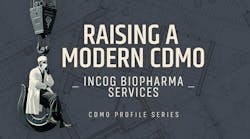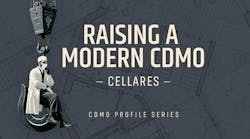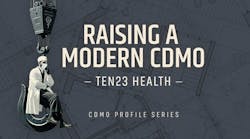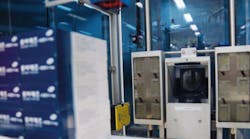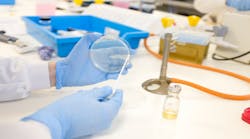Before attending a recent conference on outsourcing and globalization, I was somewhat worried about the integrity of the drug supply chain. After hearing all the precautions being taken and seeing the outline of who does what and when they do it, I’m now terrified. The two subjects of attention are raw materials (or intermediates) and finished products.
The recent problems with imported materials are in the news daily: melamine in food (pet and human), (deliberately) adulterated heparin, and ethylene glycol used in all sorts of consumer products. These are just the current headline-grabbers; Heaven only knows how many other hidden problems exist. I’m sure we’ll hear about them as people sicken and/or die. The sheer number of materials that are purchased by the Pharma industry is daunting. The tests that would need to be run to check for accidental or deliberate adulterants would be prohibitively expensive to run; but they may well have to be all run in the short term.
The heparin tests were covered in detail in a recent issue of Pharmaceutical Manufacturing: enzymatic, 2-D NMR and chromatographic work was extensive and expensive. If these tests are performed on every batch of heparin (and they are in the new USP monograph), who would pay the additional costs of testing? If the government (via the FDA) takes the lead, the taxpayers will pay the freight. If the Pharma manufacturers pay for the tests, then customers (insurance companies, included) will foot the costs. Either way, the people of the country will pay the costs (as a result of industry saving money through offshoring outsourcing).
Can the raw materials we import be made safe? Of course. At the very least, due diligence needs to be done. As far back as 1983, we were doing calls and visits to ascertain where products were made, packaged, re-packaged or re-labeled, where and how they were stored (kept cool, dry, and out of the light), and who had access to the materials. At that time, this was just for use of NIR as a test method, but it later became known as “vendor validation.” There are still a significant number of companies who do a simple ID test (USP, BP, ASTM, etc.) and accept the C of A (certificate of Analysis) as “gospel.” [It turns out that C of A’s can be generated by middle-men, not points of origin, in some cases. How can such documents be real?]
The solution, at least for raw materials, is somewhat clear. If we set up strong and consistent oversight of foreign manufacturing sites, if we use tight tracking of the lifecycle of every batch of raw materials, and if we use meaningful metrics to examine incoming raw materials (e.g., NIR or Raman, not spot, wet chemical tests), then we can trust imported raw materials. The alternative is to sit back behind our Great Wall (pun intended) and test, test, test every bag of every raw material at tremendous expense (passed on to us all, certainly not to come from company profits). And, as complicated as this solution sounds, it is orders of magnitude easier than controlling dosage forms.
As Dr. Moheb Nasr (CDER, FDA) has suggested (strongly), buying into the Quality by Design (QbD) paradigm will add a layer of protection. As we set parameter criteria for excipients, such as we now have for many APIs, for surface area, crushability, porosity, crystallinity, polymorphic form, and the like, then bad or counterfeit materials become difficult to insinuate into our products. This will entail more modern tests: fast enough to perform 100% testing, yet rich enough to spot subtle (and, of course, major) differences. NIR and Raman are just two tools made for warehouse testing of incoming materials.
While there may be some certitude about sources of raw materials (not enough profit in lactose to counterfeit it, especially under QbD tests), the routes that prescription drugs take are Byzantine, at best. Finished drug products are repackaged, resold, subcontracted, and, overall, shuffled like playing cards in Las Vegas. And, while raw materials are, in reality, single chemicals, drug products are mixtures of many chemicals, where the chemicals and the way in which they are processed (blended, granulated, pressed, and coated) are not easily distinguished from frauds.
Add to that a mish-mash of state and country regulations (or lack thereof) on the distribution of drug products. A number of states and countries allow hospitals and drug-store chains to sell back unused products to wholesalers. In addition, in an effort to control costs, retailers buy from internet sources. Now, anyone with email is aware of the vast number of SPAMs and all the on-line drug stores who offer cut-rate drugs to anyone, anywhere, any time. When a retailer buys from a warehouse, he/she has an address and face to place with a sale. There may be a better chance to detect fraud, if the wholesaler can be, in fact, located and inspected (by FDA or DEA inspectors). When drugs are purchased from on-line sources (including so-called legal, responsible suppliers), the deals are made via the Internet, the drugs are delivered by mail or commercial carrier, and electronic payments are made.
One speaker that I heard at the aforementioned conference showed a chart with boxes and arrows, indicating at least six to ten locations where the drug products become “invisible” and can easily be exchanged for counterfeit products. [One example showed a product being mixed in a cement-mixer, in a filthy small house. The color being used was the yellow paint used for lines on roads.] In the halcyon days of the 1960s and 1970s, many products were shipped from company-owned warehouses or a trusted wholesaler, one layer removed. With the incredible increase in number of products and companies (what were generics in 1970?), accompanied by wholesale food and or drug chains (i.e., Costco or BJ’s), and the advent of mass re-packagers/distributers (fueled by HMOs), the need for more and more intermediate wholesalers arose. As the complexity of the supply chain increased, so did the opportunities of less-than-honest people. The number of paths available to licit products makes it almost impossible to follow a particular lot of material (hence the title) through the supply chain.
One step being taken is some sort of “marker” on each bottle of drug product. The use of unique coding on each bottle, vial, or blister pack is being employed by some manufacturers. This alphanumeric code would not merely be the current lot number/date produced/expiry date seen on current OTC packages. It would be computer-generated, coded almost randomly, and need to be quite large, since each box of, say, 48 bottles would required 48 unique coded labels, preferably not in any easily seen series. Multiply this by the number of containers, size of containers, and the number of products sold by even a medium-sized company and the number of coded identifiers needed is astronomical. The work needed to follow these numbers is also quite a personnel- and time-intensive project. But, if this helps control the supply chain, it might be worth it.
The problem with this solution is that the coding needs, by its very nature, to be a proprietary secret. Obviously, if the protocols were widely known, the counterfeiters could duplicate legitimate codes. The conundrum here is, if you disseminate the codes to track the product, you risk giving the “bad guys” the store. If you keep the codes secret, how can the intermediate handlers of the drug products ascertain the legitimacy of the product? It is almost as if you need to know the holes (where counterfeiting takes place) in the system before you install the system. That is, you need to know all the people you can trust so that they can have access to the key. But, if these were known, coding would not be necessary in the first place.
Another method mentioned was RFID (radio frequency ID) markers, much like those used in our hands-off, electronic, highway toll collection devices (EZ Pass, IPASS, etc.). In this approach, a chip is placed on each package of solid dosage forms (or vial of lyophilized material). That means 48 different electronic signals can emanate from each case of 48 or each lot can have the same signal for each bottle. The latter can be problematic be a cause for not accounting for how many of each product is in the supply chain. It is easier to simply copy a signal than to decode a code. Of course a RFID chip is used on each case for shipping ease. That could mean 49 signals from a case when it is “interrogated” by the antenna. Again, computer power is needed, but the computers need bodies to run them and that costs money.
At first blush, this sounds like a terrific solution. However, upon closer examination, a series of problems become apparent. To begin with, there are a number of protocols available for use, much like the numerous RFID facilities servicing the highway systems throughout the country. There is no agreement on actual chips, codes, or frequencies to be used. That makes it difficult to have a worldwide protocol, when there is no agreement between any two companies in a single country. Many pharmaceutical companies are waiting for several things: upgrades in the systems used (VCH versus CDs?) before major spending is undertaken, states to pass laws or the Federal Government taking the lead (expensive systems might have to be replaced after being installed) defining the legal parameters, or an international convention through an organization such as ICH to be set.
Two-dimensional bar coding is a more sophisticated version of simple printed coding. It used a bar-code reader rather than letters and numbers. It is less likely to be altered than simple numbers and letters as it would be more apparent that it was altered (especially since bar codes are laser-scanned). The generation of these codes makes it harder for smaller counterfeiters to make anything that even resembles “real” bar coding. However, just like either of the methods already mentioned, it requires both a reader and the code to ensure authenticity.That means sharing the code with warehouse operators and customers all around the world. This generates the same problem as the alphanumeric code(s): who can you trust with the keys to the vault?
Of course, being ignored in this whole dialog are the materials contained within the packages. Just because you can read a license plate on a car, there is no proof of who is driving. Many states include cameras at intersections that photograph the driver when a traffic violation occurs. By analogy, merely tagging the drug’s container is no guarantee of the drug’s legitimacy. Safeguards similar to those suggested for excipients need to be in place for finished products.
A pharmacy cannot be expected to have NMRs or HPLCs in the store. However, small, portable, easy-to-use, and (hopefully) inexpensive spectrometers are quite feasible for end users. The initial cost of several hundred dollars (written off as a business expense) is well worth the cost of what could happen without the device. The costs could be underwritten by PhARMA (the values of counterfeits for 2007 was given as nearly $250 Billion, with possibly much more not known about) as a cheaper alternative to many of the above-mentioned approaches. If we can use the “process signature” (again, we refer to QbD/PAT) to ascertain that we have the correct product during processing, why not use this signature to foil counterfeiters?
Even if subtle counterfeits may read as “ambiguous,” I would think materials like the one using street paint could easily be spotted. Even if there is no absolute positive ID every time, the benefits of narrowing down suspects would easily pay for the program. And why wouldn’t this happen? The entrenched ideas of some parties will fight the idea tooth and nail. It would cross jurisdictions and dilute the power of some institutions. But, that's a story line for another article.

